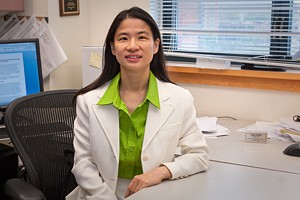
UC Moves Closer to "Cell" Control
Can you imagine the day when we will no longer have to worry about organ donors for the simple fact that we will be able to grow functioning tissues and organs in a culture dish? Thanks to Chia-Chi Ho and her colleagues at the University of Cincinnati's College of Engineering and Applied Science, this we are one step closer to making this vision a reality.
Ho is a chemical and materials engineering associate professor in the School of Energy, Environmental, Biological and Medical Engineering, working with nanotechnology to advance our understanding and control of cells. Cells within the human body are structural and functional units which migrate during many processes, such as wound healing, immune response and the formation and spreading of cancer (called cancer metastasis).
Last year, Ho and her colleagues indicated that they could guide cell migration through the use of microarrays. Microarrays are a laboratory tool, also referred to as lab-on-a-chip, which allows the researchers to interact with living cells. Ho explains, We can use microarrays to amplify the natural direction of cells and guide their continuous migration along preset paths and directions.
Building upon this discovery, Ho and her team recently discovered a new method to simply and inexpensively sort cells in a culture dish. Out of curiosity, Ho stamped a honeycomb pattern using an adhesive substance onto culture dishes and seeded them with a mixture of two different types of cells. The two cells had varying preset cell movement in their enzymes and as expected, after 72 hours, the two groups of cells separated from each other on the dish.
The technology of steering and sorting cell migration will play a large role in the future of cancer metastasis and wound healing. This discovery may lead to diagnostic tools and further down the road, tissue engineering to grow body tissue and/or organs that are functional for transplants. For now, Ho intends to work with their current revelations, to continue efforts to sort disease and cancer related cells. She states, We already have one patent pending from our research findings and we hope to move to commercialization.

Ho & students
Ho and her colleagues recent findings were released in an
titled Sorting Cells in Dishes in the science magazine, Chemical & Engineering News (C&EN). Ho has been teaching and conducting research at UC for more than ten years and has received a number of awards for teaching and mentoring students. Her research has garnered more than $3 million in funding.
In September 2011, Ho was the recipient of a
. Unfortunately, her teaching schedule precluded her from traveling to the University of British Columbia during the 2012 spring and summer quarters to work with Terrence Snutch in the Michael Smith Laboratory. She had planned to work with him and his team in research related to nanoscale technology and neuronal networks.
Related Stories
UC’s microchip training includes innovative VR
July 2, 2024
To build a virtual microchip factory, University of Cincinnati doctoral students turned to the real one where they work. UC launched a new training program for microchip manufacturing in advance of the new fabrication plant Intel Corp. is opening in Ohio.
UC grad’s innovative tech to manage ER wait times
June 25, 2024
When launching Teravus, a health care triage management startup, Jason Murray turned to the University of Cincinnati's Center for Entrepreneurship and the 1819 Venture Lab for guidance and funding.
Carnegie Foundation recognizes UC with Leadership for Public...
June 24, 2024
UC part of inaugural group honored for focusing on developing students as leaders
